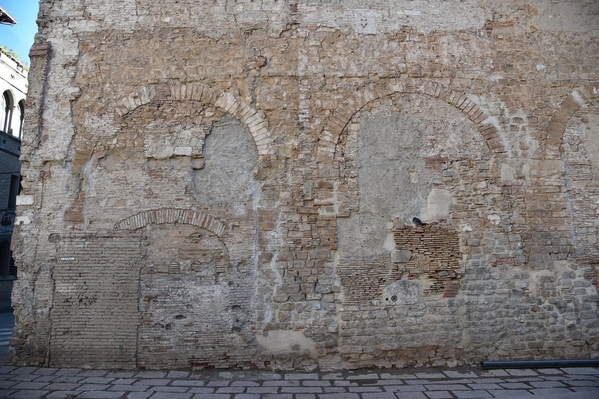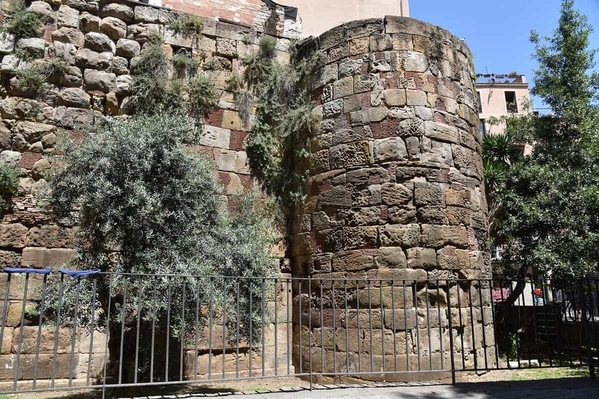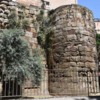Barcelona is almost littered with Roman remains—walls that have been incorporated into later buildings, aqueducts that no longer carry water but whose arches can be seen along city streets, and whole pieces of buildings and towers remodeled and put to later use.


But maybe the best place to examine the remains of Barcino—the original Roman colony that became Barcelona—is underneath the city, in the excavations under the Placa del Rei and the Cathedral. They're open to visitors as part of the Barcelona History Museum, MUHBA.
The excavated area covers several blocks, at different levels and connected by passages that can be a bit confusing, especially since what's on view at different points also reflects eras in the city's development.
Although there were people in the area before the Romans, the town itself started as a Roman camp around 15 BC, hardly the oldest or biggest Roman presence on the Iberian peninsula. But while it lacked the big names and big trade of Zaragoza or Tarragona, its daily life reflected a variety of trades and activities, mostly based on nearby agriculture.
Portions of Roman wall and building footings exposed in the area
The area was excavated mainly between 1930 and 1960, and most of what's on view dates from the first to the sixth centuries. There is a bit of residential remains, but most of the exhibit area reflects an artisan neighborhood, where large-scale laundry and dyeing work was done, where wine was made, and the potent salty fish sauce garum was made.
How archeologists fit together fragments of walls
The other major area is close to and under the Cathedral, and includes remains of earlier religious buildings, which we'll get to later on.
In the textile area, work areas and a drain. In addition to washing, the business dyed cloth in troughs like the one below, using a variety of herbs and plants for color.
Cloth was also bleached, and laundries had troughs outside to encourage passersby to contribute urine for bleaching.
The elaborate pavement below may have been part of the laundry owner's residence.
Further along, a variety of other rooms and shops along the now-buried street.
Later, portions of that area became part of an early church and burial ground, long before the dominance of Christianity.
And past that, we come to the next major industry: the garum factory, which occupied an area of about 360 square metres. Garum, as popular in ancient times as salt and pepper are today, was made by fermenting chopped fish and fish intestines in vats like the ones below. A subtle liquid form was drawn off for the rich, and the strong-smelling paste seasoned the food of the poor.
Some left-over crockery... and rooms for chopping and salting the fish.
After the fish factory (which fortunately retains no ancient odors) we come to the first remains of the 'episcopal ensemble,' the early stages of church development from the 4th to 8th centuries. We're looking here at bits of the west end of the church, from about the 6th century.
Under the pillar, which once supported an altar table, is a cavity that housed sacred relics.
Nearby, more or less around the corner, we come to a 4th-century winemaking facility, with various tanks for crushing grapes and filtering the result into transfer tanks.
Moving along a gradually-rising passage, past a display of ancient ceramics found in the excavations, it becomes obvious that we're much closer to the modern-day surface...
Down another long passage, we enter another era of Barcino's life, when Christianity had become the official religion, but Roman troops and Roman influence were fading as 'barbarian' tribes moved into more areas of the Empire. Barcino's walls were reinforced, and the bishop took on more of a governing role. Because of its midway role between 'Gallia' and 'Hispania,' trade grew around it. In this period it also became known as Barcinona.
The newcomers, mainly Visigoths, lived primarily outside the town's walls, but had a growing influence that can be traced in household objects of the time.
As the bishop became more and more the principal source of law, justice and government, the episcopal quarters became larger and more elaborate.
Some of the structures of the period are reached through the museum's excavations, but are actually part of the Cathedral, which, like most others, incorporates big pieces of its predecessors. This is the original 5th century baptismal pool.
MUHBA, the Barcelona History Museum, operates more than a dozen sites around the city, including several others focusing on Roman remains.



Comments (0)